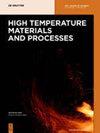熔融铝硅基合金的密度和表面张力测量
IF 1.5
4区 材料科学
Q4 MATERIALS SCIENCE, MULTIDISCIPLINARY
引用次数: 0
摘要
摘要本研究是一系列研究的一部分,旨在测量873附近熔融相变材料型金属储能材料的热物理性质 K(600°C)。目标材料是Al–Si基合金。首先,作为可行性研究,对三种Al–Si二元合金(Al–12.2Si、Al–50Si和Al–90Si,以原子%计)的熔融状态进行了密度测量。密度测量方法采用了一种基于静态磁场叠加电磁悬浮(EML)方法的高精度非接触式密度测量方法。该实验方法的有效性得到了证实,并测量了熔融Al–Si基合金(ADC12和Al–5.9mass%Si–1.6mass%Fe)的密度作为温度的函数,扩展不确定度为1.2%。此外,使用EML技术通过液滴振荡法测量了合金的表面张力。成功地获得了表面张力作为温度的函数,扩展不确定度为2.3%。本文章由计算机程序翻译,如有差异,请以英文原文为准。
Density and surface tension measurements of molten Al–Si based alloys
Abstract This study is part of a series of studies aimed at measuring the thermophysical properties of molten phase change material-type metallic thermal energy storage materials near 873 K (600°C). The target material is Al–Si based alloys. First, as a feasibility study, density measurements of the molten state of three Al–Si binary alloys (Al–12.2Si, Al–50Si and Al–90Si in atomic%) were performed. A highly accurate non-contact density measurement method based on the static magnetic field superposition electromagnetic levitation (EML) method was employed as the density measurement method. The validity of this experimental method was confirmed, and density of molten Al–Si base alloys (ADC12 and Al–5.9mass%Si–1.6mass%Fe) were measured as a function of temperature with an expanded uncertainty of 1.2%. In addition, the surface tension of the alloys was measured by the droplet oscillation method using the EML technique. The surface tension was successfully obtained as a function of temperature with expanded uncertainty of 2.3%.
求助全文
通过发布文献求助,成功后即可免费获取论文全文。
去求助
来源期刊

High Temperature Materials and Processes
工程技术-材料科学:综合
CiteScore
2.50
自引率
0.00%
发文量
42
审稿时长
3.9 months
期刊介绍:
High Temperature Materials and Processes offers an international publication forum for new ideas, insights and results related to high-temperature materials and processes in science and technology. The journal publishes original research papers and short communications addressing topics at the forefront of high-temperature materials research including processing of various materials at high temperatures. Occasionally, reviews of a specific topic are included. The journal also publishes special issues featuring ongoing research programs as well as symposia of high-temperature materials and processes, and other related research activities.
Emphasis is placed on the multi-disciplinary nature of high-temperature materials and processes for various materials in a variety of states. Such a nature of the journal will help readers who wish to become acquainted with related subjects by obtaining information of various aspects of high-temperature materials research. The increasing spread of information on these subjects will also help to shed light on relevant topics of high-temperature materials and processes outside of readers’ own core specialties.
 求助内容:
求助内容: 应助结果提醒方式:
应助结果提醒方式:


